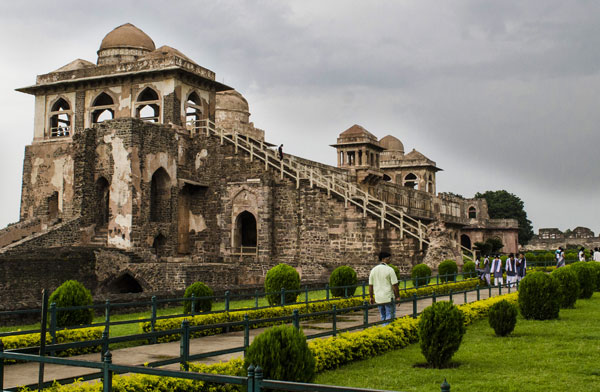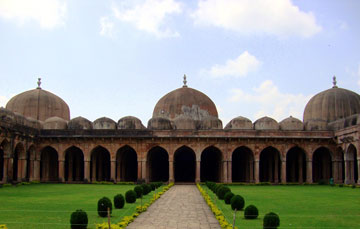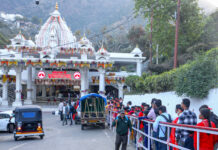Wonderful palaces, canals & a fairy tale love story
 Fairy tale love story of a Muslim prince with a local poor shepherd girl brings the mythological face to Mandu. Mandu, a small town on the edge of Malwa Plateau in Madhya Pradesh, is surrounded by forests and has a historical significance. History tells us that the founder of this cute, beautiful town was Raja Bhoj and it was once a royal retreat.
Fairy tale love story of a Muslim prince with a local poor shepherd girl brings the mythological face to Mandu. Mandu, a small town on the edge of Malwa Plateau in Madhya Pradesh, is surrounded by forests and has a historical significance. History tells us that the founder of this cute, beautiful town was Raja Bhoj and it was once a royal retreat.
Architectural marvel is the main attraction in this city. Remains of ancient architecture, way back to 10th century, are still visible. Mandu has the finest examples of Afghan architecture in India. The town is a monument of love, romance and affection as it is believed that this place is associated with the love legend of Prince Baz Bahadur and singer Roopmati, the beauty of the city. The relationship of the Muslim prince with the shepherdess Hindu girl was however destined to fail.
The Mandu region has a number of wonderful palaces, baths, attractive canals and artistically crafted pavilions bringing out the age old fairy tale love story with all its beautiful pomp. Rock cut caves with enchanting paintings decorating the walls and ceilings are added attractions.
Antiquity and artistry merges here to bring some marvelous structures. The massive gateways to Mandu are an example of this ancient artistic excellence. It is a city of monuments like Alamgir, Bhangi, Rampol Darwaza, Jehangir Gate and Tarapur Gate.
Mandu is one of the few places where the very rare Baobab tree grows.
Mandu welcomes the visitors will all its charm and heritage. It is the perfect honeymoon destination as it is the city of love and delight.
Climate
Mandu experiences a tropical climatic condition all through the year. Summers (March to June) in Mandu are slightly hot, but overall pleasant due to its elevated position. The temperature ranges from 35°C to 20°C during summers. Winters (October to February) are cool and pleasant. Maximum day time temperature is 22°C and temperature drops down to a minimum of 7°C during nights. Monsoons (July to September) have medium level annual rainfalls. Time to visit Mandu is all through the year and the best during July to March
History
The history of Mandu talks about the romantic tale of Rani Roopmati and Baz Bahadur, a poet-prince. The history of the ‘City of Joy’ dates back to 10th century, when it was founded by Raja Bhoj. Though the city finds its mention in the Sanskrit inscription of 555 A.D., not much of it has been retained.
The city was referred as Mandavgarh under the rule of Parmara rulers in the 11th and 12th century. However, the name was changed to ‘Shadiabad’ (meaning happiness) by Alauddin Khilji, who gained control over the city in the 13th century.
After the conquest by the Mughals in 19th century, the town was ruled by Hoshang Shah, the son of Dilawar Khan. However, Akbar attacked the city in 1561 and gained control. Baz Bahadur fled from Mandu in order to save his life and the town of Mandu remained unoccupied for quiet some time.
Tourist attractions
 Jami Masjid: Built in 1454, the Jami Masjid is the most majestic building in Mandu. It is designed after the Omayyed Mosque of Damascus. The best view of this monument is from the Ashrafi Mahal rising in front of it.
Jami Masjid: Built in 1454, the Jami Masjid is the most majestic building in Mandu. It is designed after the Omayyed Mosque of Damascus. The best view of this monument is from the Ashrafi Mahal rising in front of it.
Hoshang Shah’s Tomb: A massive, foursquare monument with a huge dome, constructed in AD 1435, it is the oldest marble structure in India and depicts typical Hindu influences. An inscription on the right jamb of the door mentions the name of Ustad Hamid who was involved with the building of the Taj Mahal in Agra.
Jahaz Mahal: It is one of the most popular monuments in Mandu, this ship-like structure was erected by Ghiyas-ud-din, son of Mohammed Shah, for his harem. According to legend, this harem was home to 15,000 maidens. There are two lakes on the east and west side of the palace that create a perfect illusion of a ship with its rectangular shape.
Hindola Mahal: It’s a large hall supported by sloping buttresses which, resembles the supports of a swing. According to legends, both the Jahaz and Hindola Mahal were popular with the Mughals for partying on monsoon evenings.
Champa Baoli: Champa Baoli is an interesting step-well on the north edge of the tank situated there. It was a popular hot-weather retreat and featured cool wells and bathrooms.
Baz Bahadur’s Palace: The Rewa Kund is actually a tank of sacred water from the river Rewa, another name for the Narmada. This is the place where the love of poet-prince Baz Bahadur and Rani Roopmati flourished. Baz Bahadur was the last independent king of Malwa who fell in love with an ordinary shepherdess called Roopmati. Unfortunately, their love had a tragic end when the great Mughal emperor, Akbar, moved by Roopmati’s beauty, attacked Mandu and Baz Bahadur fled leaving his lover to poison herself. Baz Bahadur’s Palace was constructed in 1509 beside the Rewa Kund.
Roopmati’s Pavilion: Roopmati’s Pavilion, is situated on the very edge of Mandu Fort. It is a very romantic building, a perfect setting for fairytale romance!
Nilkanth Temple: Nilkanth (literally, the blue-throated one; another name of Lord Shiva) is a shrine dedicated to Shiva.
How to reach
By train: Nearest railhead is Ratlam railway station, which is about 125 km from Mandu. It is well connected to the rest of the major cities in India and is an important junction in the western railways.
Air: Indore Ahilyabai Holker Airport is the nearest airport to Mandu. Mandu is about 100 km from the airport.
By Bus: State owned buses connect many cities in Madhya Pradesh to Mandu. Deluxe buses are available from Indore (100 km), Bhopal (278 km), Ratlam (125 km) and Ujjain.






